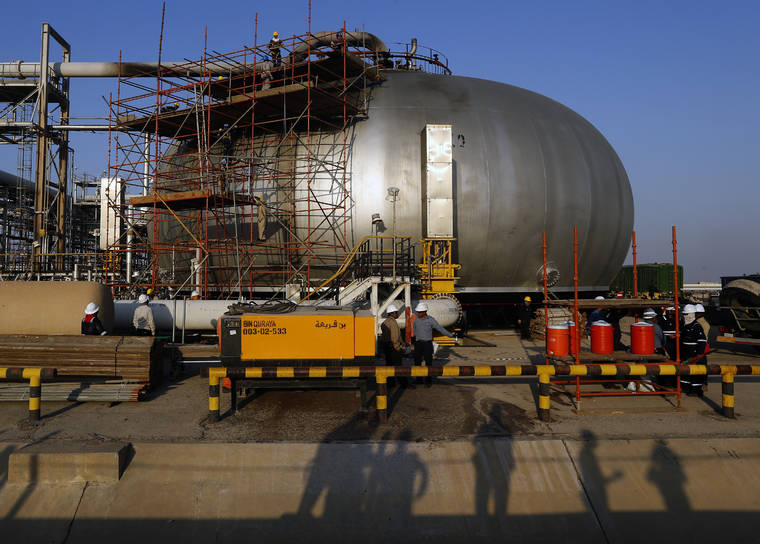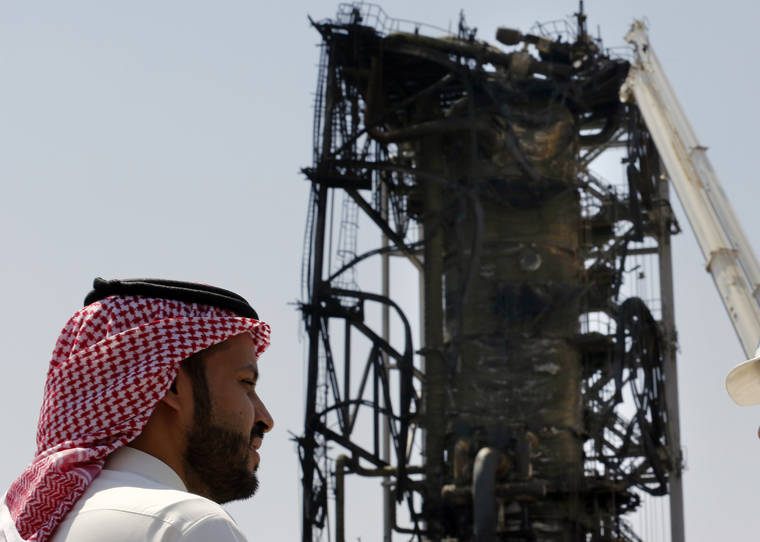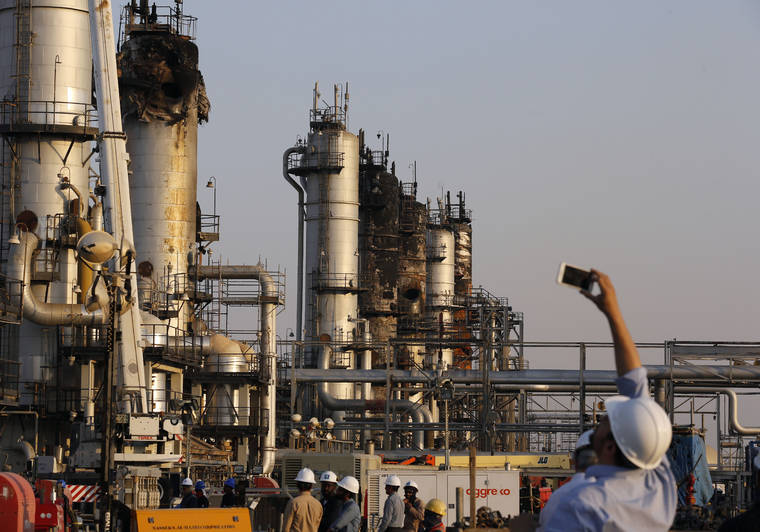BUQAYQ, Saudi Arabia — The heart of Saudi Arabia’s oil industry remained wrapped in scaffolding Friday as workers sought to repair the charred innards and shrapnel-blasted arteries caused by drone-and-cruise-missile attacks that raised tensions between the U.S. and Iran.
Saudi officials brought journalists to the kingdom’s crucial Abqaiq oil processing facility, described by the state-run oil giant Saudi Aramco as “the largest crude oil stabilization plant in the world.” It was the first such trip for outsiders to see the damage done to its facilities that have been targeted in a summer-long campaign of attacks.
Saudi Arabia is seeking to build international consensus ahead of the U.N. General Assembly next week after the Sept. 14 attack that it claims was “unquestionably sponsored by Iran.” The U.S. has gone further, alleging Iran carried out the attack as part of a campaign seeking to roil the region as American sanctions on its oil industry prevent it from selling crude oil abroad as Tehran’s 2015 nuclear deal with world powers collapses.
Iran has denied involvement in the attack that was initially claimed by Yemen’s Iranian-backed Houthi rebels. Iranian Foreign Minister Mohammad Javad Zarif, now heading to New York for the high-level meetings at U.N. headquarters, has warned that any retaliatory strike on Iran by the U.S. or Saudi Arabia will result in “an all-out war.”
President Donald Trump, who withdrew the U.S. from the nuclear deal more than a year ago, said separately Friday that America “just sanctioned the Iranian national bank.” He did not elaborate.
In Abqaiq, an oil facility in the Arabian Peninsula’s sprawling Empty Quarter desert, journalists saw what previously only had been glimpsed in satellite photos released earlier by the U.S.
The attack punched holes in giant metal onion-shaped structures that help separate gas from crude oil. Separation towers there, which process crude oil, were scorched and damaged, with the top of one looking like a melted candle.
Officials said they put out about 10 large fires at the site less than seven hours after the attack. There were at least 18 direct hits on 11 of the spherical structures, five column stabilizers and two small processing facilities, they said.
Abqaiq processes sour crude oil into sweet crude, and it is transported to transshipment points on the Persian Gulf and the Red Sea or to refineries for local production. Estimates suggest it can process up to 7 million barrels of crude oil a day. By comparison, Saudi Arabia produced 9.65 million barrels of crude oil a day in July.
The plant has been targeted before by militants. Al-Qaida-claimed suicide bombers tried but failed to attack the oil complex in February 2006. However, the Sept. 14 attack reached deep inside a facility that analysts long warned was vulnerable, knocking out half of the kingdom’s oil production and spiking crude prices this week by a percentage unseen since the 1991 Gulf War.
Saudi Arabia also flew journalists to its Khurais oil field to see damage done to the oil field, which is believed to produce over 1 million barrels of crude oil a day. Officials there said 110 contractors evacuated the site after the attack, but there were no injuries. They said the oil field was back online within 24 hours of the attack.
An oil stabilization tower was damaged and other pipes had holes from the attack.
Repair crews swarmed both sites beneath large cranes, working through the heat. Saudi Arabia says it already has restored half of the cut production and hopes to have it fully online by the end of the month, although damage at several structures seen by journalists looked severe.
The trip comes as Saudi Arabia hopes to offer a sliver of Saudi Aramco in an initial public offering, a key component of Crown Prince Mohammed bin Salman’s development plans for the kingdom. Opening up the facilities slightly to journalists both bolsters Saudi Arabia’s push for international condemnation of the attack while offering at least a glimpse at the crown jewels ahead of the IPO.
While Yemen’s Houthi rebels claimed responsibility for the assault, analysts say the missiles used wouldn’t have enough range to reach the site from the impoverished nation. The missiles and drones used resembled Iranian-made weapons, although analysts say more study is needed to definitively link them to Iran.
A Saudi-led coalition has battled the Houthis in Yemen since March 2015, a conflict that has killed tens of thousands of people and sparked what the U.N. describes as the world’s worst humanitarian crisis.
The International Crisis Group warns that the Saudi attack could push the wider Persian Gulf into war, saying the risk of conflict is “arguably the highest it has been in years.”
“The Aramco strikes were no minor incident: They were perhaps the most significant attacks on Saudi Arabian infrastructure in modern history, and the result of a series of provocations and tit-for-tat exchanges that have been allowed to gather momentum for too long,” the group said. “At this point, a single misstep could set off a chain reaction.”
Underlining that Friday was Iranian Gen. Rahim Safavi, a senior adviser to Iranian Supreme Leader Ayatollah Ali Khamenei.
“If the Americans think of a conspiracy, the Iranian nation will respond to them from the Mediterranean Sea, Red Sea and Indian Ocean,” Safavi said, according to the state-run IRNA news agency.
Also on Friday, the tiny, oil-rich country of Kuwait said it would increase security at both its commercial and oil ports. Kuwait’s state-run KUNA news agency reported the decision, quoting Khaled al-Roudhan, the minister of commerce and industry.
———
Gambrell reported from Dubai, United Arab Emirates. Associated Press writer Amir Vahdat in Tehran, Iran, contributed.




